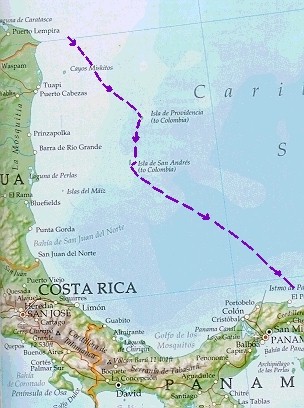 4/15/02
- arrived in
Catalina Harbor on the northwest coast of the
island of Providencia.
Just to the northeast of Providencia and
connected
by a floating foot-bridge is Catalina Island, a former hang-out of the
English pirate Captain Morgan. Most of the islanders proudly claimed
descent
from pirates and true to their English ancestry, they spoke an
English-like
language. But since they are now Colombian there is a strong Spanish
influence.
4/15/02
- arrived in
Catalina Harbor on the northwest coast of the
island of Providencia.
Just to the northeast of Providencia and
connected
by a floating foot-bridge is Catalina Island, a former hang-out of the
English pirate Captain Morgan. Most of the islanders proudly claimed
descent
from pirates and true to their English ancestry, they spoke an
English-like
language. But since they are now Colombian there is a strong Spanish
influence.
Providencia
is a sleepy place. There are some tourist resorts on the south part of
the island and an occasional cruise ship visits, but the reefs are a
couple
of miles from the anchorage - too far for frequent snorkeling trips,
and
the one road that circles the island only takes about an hour to
explore.
We found one restaurant that was open consistently: Eneida's on
Catalina
Island, so we went there frequently. The beers here are a little
smaller
than the typical 12 oz., weighing in at 300 ml or just over 10 oz, but
they only cost 1,000 pesos or about $0.45, so still a good deal
especially
when ice cold!
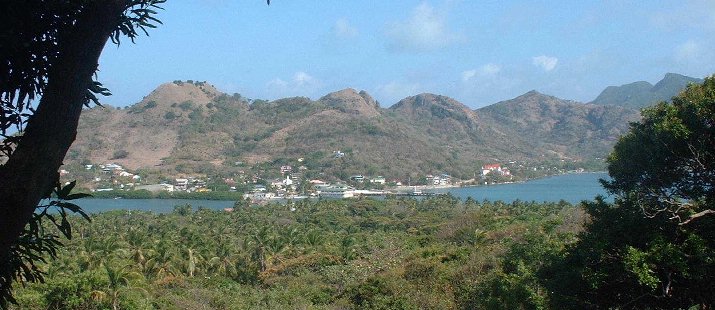
Providencia as seen from
the
slopes of the considerably greener Catalina Island.
4/30/02
- Having pretty
much
exhausted the touristic
opportunities
in Providencia and having a long list of boat projects that could be
achieved
in proximity to hardware stores, we sailed for the more urban island of
San Andres under a
waning
but still bright moon. San
Andres is about 50
miles south southwest of Providencia, so a relatively easy sail for us
in the prevailing easterly trade winds.
San Andres is a popular
destination for Colombians from
the
mainland,
with jumbo jets arriving and departing regularly from Bogota.
Although most of our time here was spent on boat projects, we
took time
out to do some touristy things like ride a golf cart for a
visit to the blow hole at the south end of the island.
While
in San Andres, we
repaired a leak near our
main
hatchway, installed
a washdown pump for the anchor chain, repaired our instrument system,
repaired
our diesel engine, made minor repairs and varnished the mast, did some
sewing projects, handled a package of mail, and restocked with
provisions
for an extended stay in the San Blas islands. We met the crews of the
sailboats
"Galatea", "Indara", "Restless", "Dalliance", "Lydia B", "Journey" and
"Nous Deux". We became good friends with the staff of Tonino's Marina -
Tonino, Capt. Marco Newball, Fernando, Gregory, Jose, and Hoche. We
hung
out with the launcha drivers who keep their boats in the marina -
Truman,
Mario, Beethoven, Ethan, and several others whose names we never quite
were able to catch.
The people we met in San
Andres were exceptionally
friendly
and helpful.
Whenever we ran into a difficulty, there was always someone ready to
offer
some helpful suggestions or give us directions to just the right store
or shop where we could find the part or supply we needed.
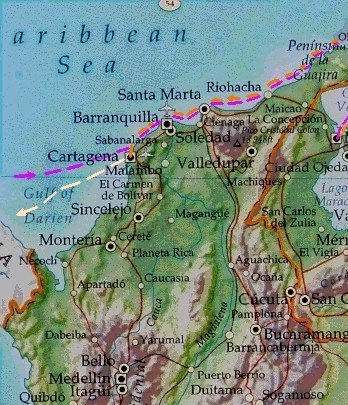 July
2002 - We had a long trip to make in a short time against adverse wind
and
current to reach Maracaibo, Venezuela
from the San Blas Islands of
Panama in the month of July 2002. We traveled west to east along the
Colombian-Caribbean coast but did not officially enter the country.
July
2002 - We had a long trip to make in a short time against adverse wind
and
current to reach Maracaibo, Venezuela
from the San Blas Islands of
Panama in the month of July 2002. We traveled west to east along the
Colombian-Caribbean coast but did not officially enter the country.
Our friends on "Ithaka" have a good summary
of our voyage at Cruising World.
We departed from the central part of the San Blas on the third of July
and tied up at a dock in Maracaibo, Venezuela on July 24, 2002. For
almost the entire intervening time, we were pushing toward our goal. We
used our anchor time to sleep or make repairs so we could press onward
the next day - no sight-seeing. In retrospect, we realize we were quite
lucky on this passage since several subsequent sailing voyages of this
coast reported by others were marred by incidents of piracy at
Punta Hermosa. We speculate that we may have been spared because our
direction of travel - up wind along this coast - clearly signalled to
locals that we were deranged.
 A
highlight of that journey was our visit to Guayraca, near Santa
Marta about the middle of the Colombia coast - behind a very rocky
headland, we came upon this remote settlement in a deep bay where the
towering Santa Marta Mountains meet the Caribbean. We had been advised
that this particular harbor was the home of some friendly people who
could help us obtain some desperately-needed diesel fuel. This was one
of the only places in Colombia where we visited people ashore during
this trip.
A
highlight of that journey was our visit to Guayraca, near Santa
Marta about the middle of the Colombia coast - behind a very rocky
headland, we came upon this remote settlement in a deep bay where the
towering Santa Marta Mountains meet the Caribbean. We had been advised
that this particular harbor was the home of some friendly people who
could help us obtain some desperately-needed diesel fuel. This was one
of the only places in Colombia where we visited people ashore during
this trip.
Sand Dollar at Guayraca
(near Santa Marta)
As anticipated, we met the Garcia family within minutes of arriving
ashore. Jonathan Garcia, age 15, was at the beach to meet us and make
sure we found the grocery store and had a chance to see his father's
collection of artifacts. We soon learned that Reynaldo Garcia makes his
meager living from excavating the local hillside for artifacts from the
1,000 year old Tiarona indian culture that occupied this area and
apparently had a rather large burial site covering the hillsides around
modern-day Guayraca. They buried the remnants of dead relatives in
ceramic urns - after cremation or a time of dessication we imagine,
since the urns are not very large. Some urns were also used to store
food items and once in a while a piece of jewelry. It is these latter
urns that Mr. Garcia seeks to support his two boys - his wife died some
years ago.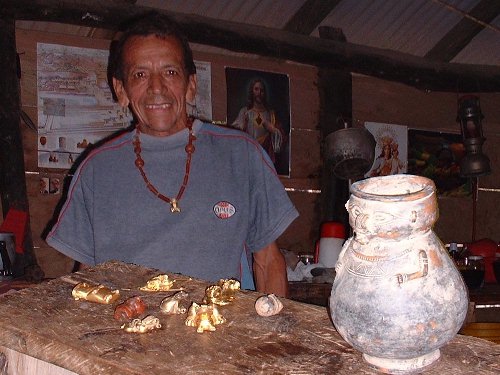
Mr. Garcia was very proud of his discoveries - fancies himself
somewhat of an archaeologist, though of course his actions completely
destroy the archaeological value of the site. We were toured around the
area by Jonathan the next day and learned that excavation of the area
has been a local industry for more than 30 years. Reynaldo was able to
obtain 40 gallons of diesel fuel for us. He and a friend who has a taxi
in a nearby town, brought it to us a couple of days after we arrived,
and all too soon, we were preparing to depart again.
Reynaldo the
"excavator"
The Colombian coast is not heavily populated despite the presence of
cities like Cartagena and Baranquilla. Most of the times that we
approached land it appeared completely deserted, and as we went further
east, it also became quite desert-like. We spent a night tucked behind
the point of a narrow headland at the entrance to Bahia Honda - close
to the northernmost tip of the South American continent. We went ashore
to stretch our legs and see if the land could really be as desolate as
it appeared from off shore. It was.
June 2004
- we headed for Aruba from Maracaibo at tthe end of our
teaching contract in Venezuela, but the wind gods hinted
none-too-gently that it would not be in our best interest to pursue
that course. Two consecutive evenings of greater that 40 knots of wind
in the Gulf of Venezuela persuaded us to return westward along the
Colombia coast to Cartagena.
It is a much more forgiving coast when transited down wind! On this
trip, we spent a leisurely week in Guayraca with the Garcia family and
other new friends. We were there for the weekend of July 5 - which is a
date somehow associated with Simon Bolivar (aren't all dates somehow
associated with him, we have begun to think?) Anyway, the beach at
Guayraca was full of kids who mounted a series of expeditions to visit
the sailboat. Over the course of the day we had about 60 guests aboard
as waves of kids, and later their parents found ways out to visit and
have a peek.
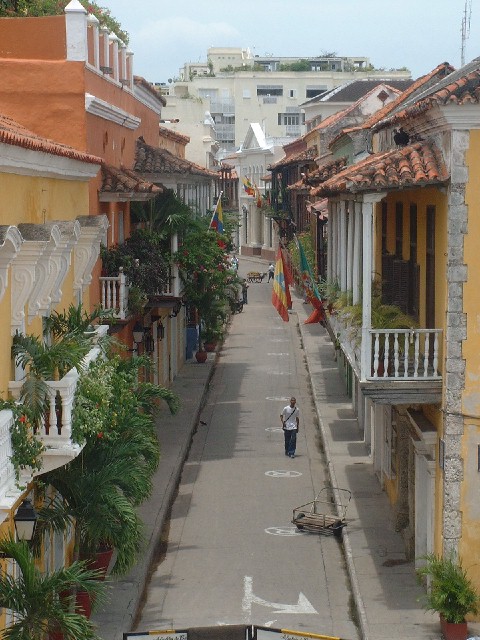 July
2004 - Cartagena is a beautiful city full of friendly people,
historic buildings, and good food. We did not have much time to savor
the city in our first month because we were diligently investigating
shipyards. There were three here that catered to sailors: Ferrocem (now
FerroAlquimar),
Todomar, and Manzanillo. We found it very difficult to make our final
choice between Ferrocem and Manzanillo in the final analysis, but
finally the convenience of an on-premises restaurant convinced us to go
to Ferrocem.
July
2004 - Cartagena is a beautiful city full of friendly people,
historic buildings, and good food. We did not have much time to savor
the city in our first month because we were diligently investigating
shipyards. There were three here that catered to sailors: Ferrocem (now
FerroAlquimar),
Todomar, and Manzanillo. We found it very difficult to make our final
choice between Ferrocem and Manzanillo in the final analysis, but
finally the convenience of an on-premises restaurant convinced us to go
to Ferrocem.
a pretty avenue in old
Cartagena as seen
from the outer fortifications
We had a very productive month of August 2004 in the shipyard (and
Lisa took some time out to visit her mom in Kentucky). We had a
hard-top bimini top made on our refurbished stern rail, had the deck
repainted and the mast taken down for some TLC and replacement of lower
stays, repaired a couple of seacocks that had been leaking, had the
bottom and topsides painted and the name painted on, had a captain's
chair built for the cockpit, ports and turnbuckles plated with chrome
and new glass and gaskets installed, a new larger fuel tank, and some
repairs to the cockpit seats. It was a big project for us and we spent
a lot of money in the shipyard - 8 million pesos for our work crew for
the month, 5 million for stainless steel work, about 4 million on
materials, 3.5 million on stays and end-fittings, and another couple of
million for the shipyard space. At 2500 pesos to the dollar, that is
about $9,000 of work - more than we'd planned, but we found the labor
rates quite favorable and the workmanship was good. Everything we did
was helpful and will make an improvement in our living, so it was well
spent. We set up a separate page for our work
crew to show off their work a little.
the Bazurto market area
(on a slow
day!)
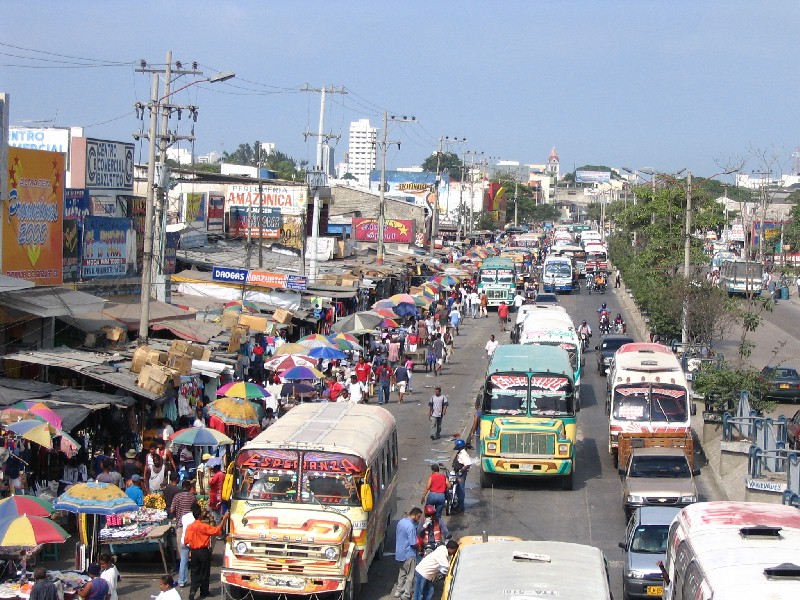 We
left the shipyard at the end of August and tied up at the docks
of Club Nautico to spend a few days washing off the remaining shipyard
grit, put the sails back in place, take out the accumulated trash,
refill the water tanks, and generally recover. Since the Club Nautico
dock cost $0.25 per foot per day, plus $3.00 per day for water and
electricity, we could not stay long. It is better for us to be out at
anchor and only have to pay $2.00 per day for dinghy dock access and
use of the Club Nautico showers (open air - nice on a sunny day).
We
left the shipyard at the end of August and tied up at the docks
of Club Nautico to spend a few days washing off the remaining shipyard
grit, put the sails back in place, take out the accumulated trash,
refill the water tanks, and generally recover. Since the Club Nautico
dock cost $0.25 per foot per day, plus $3.00 per day for water and
electricity, we could not stay long. It is better for us to be out at
anchor and only have to pay $2.00 per day for dinghy dock access and
use of the Club Nautico showers (open air - nice on a sunny day).
There were several friendly cruisers hanging out at Club Nautico,
and quite a few expatriates of various countries who had more or less
settled into Cartagena on a permanent basis. We understood the
inclination since we found prices to be almost as low as in neighboring
Venezuela, the climate very agreeable, the city picturesque and the
people uniformly friendly: we began to truly get back into the cruising
lifestyle mode at last.

Cade swimming near some Goliath groupers at the
Oceanario
October 2004 - we began taking trips out to the
nearby Rosario
Archipelago every other week or so to clean away barnacle accumulation,
get a swim in some clear and clean water, and get a little change of
scenery. Each trip of five to seven days would be spent in one of the
many pleasant and protected anchorages in this group of islands 18
miles southwest of Cartagena, and we spent much of our time there
working as volunteers in the Oceanario, a privately owned sea aquarium
facility that had daily dolphin and shark shows, and also featured some
nice laboratories for a fledgling effort to conduct some marine biology
research. We were put to work in the Conch lab, helping establish a
hatchery for queen conch that may eventually be able to restock the
local reefs with these interesting creatures.
By mid-December, over 50 sailboats were anchored off Club Nautico
and as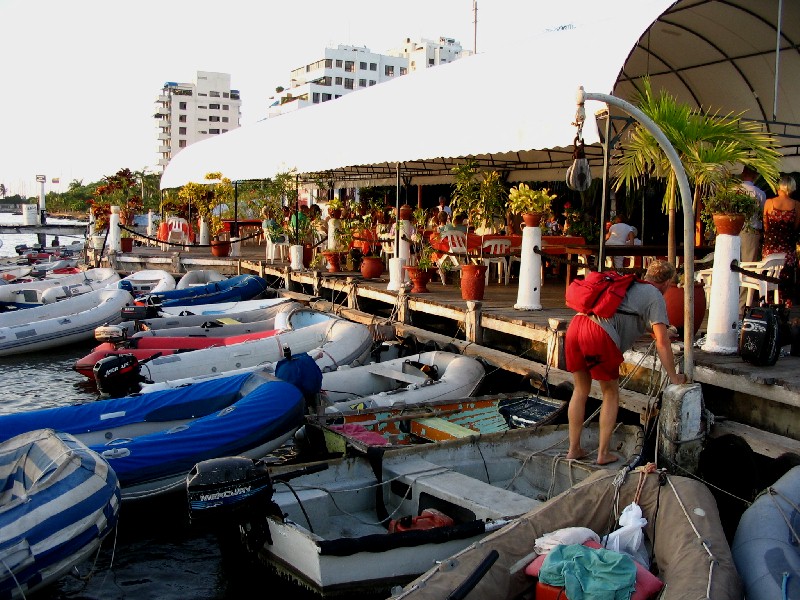 many more were docked. We met many new friends and saw many
continue on with their travels.
many more were docked. We met many new friends and saw many
continue on with their travels.
dinghies jamming the
dock at Club Nautico
Lisa became an avid participant in the
afternoon games of Baja rummy, Mexican Train and Chickenfoot dominoes,
and the occasional bead stringing and jewelry making sessions. Cade
found some chess players and we whiled away many pleasant afternoons on
the deck at Club Nautico. A hundred people participated in the
Christmas Pot-luck dinner, and then the crowd here began to wane. There
were still dozens of anchored boats around by New Years Eve, but many
began to talk of plans to sail westward to the San Blas of Panama or
toward the northwest. We determined to move on to Panama
as well.
Lisa aboard the Colombian training ship "Gloria"
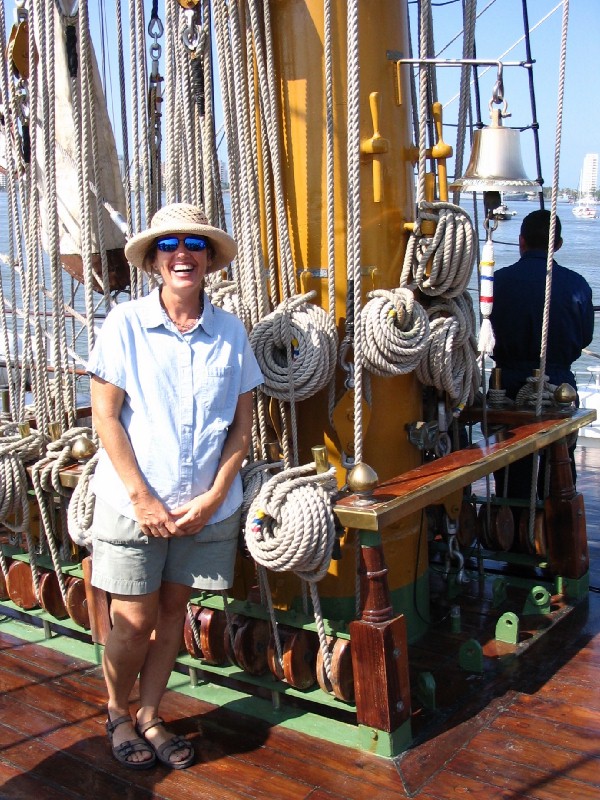
July
2005 - we returned to Cartagena from the San Blas in the
company of Ithaka and Mesqua Ukee. Cartagena was almost like we left
it, but perhaps slightly more prosperous under the continued beneficial
leadership of President Uribe. This year, we did not visit the
shipyards - but nor did we have time for volunteer work at the
Oceanario. We worked on a new list of boat projects instead - building
a hard dodger to go with last year's bimini, deck lockers for propane
and general storage (to go with converting the galley stove to
propane), replacing chain-plate bolts, doing some LED lighting projects
(see our article in the September 2005 issue of Good Old Boat!),
varnishing and painting, rebuilding the engine transmission, and of
course conducting numerous hardware hikes to help orient our fellow
cruisers, and organizing various social events such as Sunday afternoon
games on the deck at Club Nautico and excursions to various events
during the holiday season.
Cruisers we met
in Cartagena in 2004:
Abu Dei - Anne & Bruz
Amulet - Nancy & Chris
Australia 31 - Yvonne & Bernie
Chewbacca - April, Bruce, Kendall & Quincy
Chi Lin - Patty & Mike
Erin Brie - Vicki & Greg
Felicia777 - Carol & Gregory
Fifth Season - Gail & David
Friction - David
Gabrielle - John
Gonzo II - Jean & Bud
Gosi - Barbara & Tom
Illusions - Katy &
Jeff
La Cardinalia - Maximo
Lady Domina - Irvin
Leprechaun - Terry & Iris
Leprechaun - Beth, Joe & family
Malola - Eric & salty
Maya III - Colin
Mesqua' Ukee - Lyette & Tom
Mon Dragore - Dominique, Patrick & salsa
Mystiqu - Sherry & Ted
Oasis - Kyoko & Ed
Promesa - Blanca & Leo
Queen Mary - Brenda & Gene
Rived - Margo & Clive
Shilo - Sonja
& Harry
Sun Dazzler - Janice & Dorcy
Sundancer III - Bobbi & Noel
Trinka - Kara & John
Vagamundo - Natalia & Luis
Velela - Bill
Velela II - Mo & Charlie
Windsong - Yvonne & Bill
Xtazy - Nancy & Paul
... and in 2005, many of the same plus:
(wait for it - still collecting names!)





